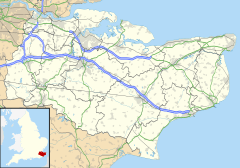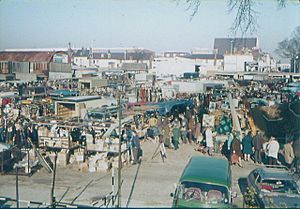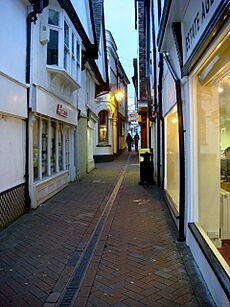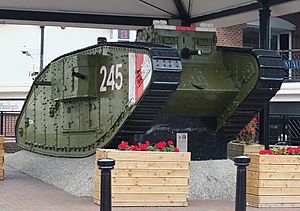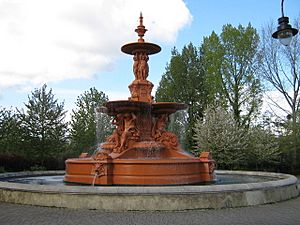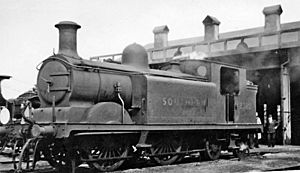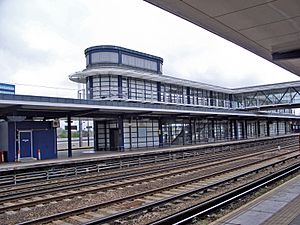Ashford, Kent facts for kids
Quick facts for kids Ashford |
|
|---|---|
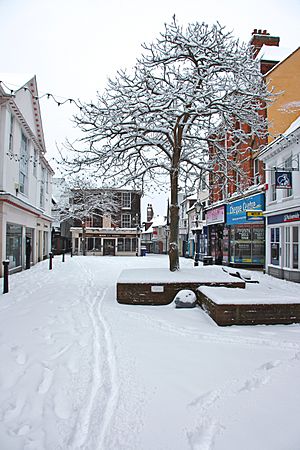 High Street, Ashford, in February 2012 |
|
| Population | 83,213 (2021 Census) |
| OS grid reference | TR005425 |
| District |
|
| Shire county | |
| Region | |
| Country | England |
| Sovereign state | United Kingdom |
| Post town | ASHFORD |
| Postcode district | TN23–TN27 |
| Dialling code | 01233 |
| Police | Kent |
| Fire | Kent |
| Ambulance | South East Coast |
| EU Parliament | South East England |
| UK Parliament |
|
Ashford is a town in the Ashford district, located in Kent, England. It sits by the River Great Stour, near the southern edge of the North Downs. The town is about 61 miles (98 km) southeast of central London. In 2021, Ashford had a population of 83,213 people.
The name "Ashford" comes from an old English word, æscet. This means a place where you can cross a river (a ford) near a group of ash trees. Ashford has been a market town since the Middle Ages, and markets are still held regularly today.
St Mary's Parish Church has been an important building since the 13th century. It was made bigger in the 15th century. Today, the church is used for both religious services and fun events.
The arrival of railways in the mid-1800s helped Ashford grow a lot. It became a major railway hub with five different train lines. The HS1 High Speed 1 line, which connects London to the Channel Tunnel, goes through Ashford International Railway Station. This links Ashford to places like Paris in Europe. The M20 motorway also connects Ashford to the Channel Tunnel and other major roads.
Ashford has been chosen for growth in many government plans since the 1960s. Over the last 40 years, new buildings and areas have been added. These include the County Square shopping centre and the Ashford Designer Outlet, which has won awards.
Contents
History of Ashford
Early Settlements
People have lived around Ashford since the Iron Age. Tools from as far back as 7000 BC have been found here. During the Roman Britain, iron was mined nearby and brought to Ashford. Here, two ironworks turned the ore into metal. Experts believe a Roman settlement was located north of the current town centre.
The town we know today started in 893 AD. People escaping a Viking raid were given land by a Saxon Lord. The name "Ashford" comes from the Old English word for a ford near ash trees. In 1086, the town was called Essetesford in the Domesday Book. It had a church and two mills. One of the oldest houses still standing is Lake House at Eastwell Park.
Medieval Times
Ashford became more important as a farming and market town in the 13th century. In 1243, King Henry III allowed the town to hold a market for livestock. Pottery making also grew in the 13th and 14th centuries. Large amounts of pottery were made at Potter's Corner, west of the town.
Jack Cade, who led a rebellion in 1450, might have had connections to Ashford. In a play by William Shakespeare, a character called "Dick, the Butcher from Ashford" appears.
In the 16th and 17th centuries, Ashford was known for nonconformism, which meant people who didn't follow the main church. John Wallis, a famous mathematician who taught Isaac Newton, was born in Ashford in 1616.
Modern Developments
By the late 1700s, farmers held markets in Ashford's High Street. In 1856, the market moved to Elwick Road. The company that runs it is the oldest registered company in England and Wales. There is still a regular street market in town.
Military Presence
The Army first came to Ashford in 1797. They built a garrison on Barrow Hill. During World War I, Ashford was a target for bombs because it was a transport hub. A bomb in 1917 killed a young woman. During World War II, Ashford was attacked in the Battle of Britain.
The Joint Services School of Intelligence was at Templer Barracks. Prince Andrew attended a course there in 1982. The barracks closed in 1997.
Ashford has been linked with the German town Bad Münstereifel since the 1900s. British soldiers occupied the town after World War I. This led to friendships and exchange visits between families. The two towns officially became "twinned" in 1964. Ashford also twinned with Fougères, France, in 1984.
Industry and Business
In the early to mid-1900s, printing became an important industry in Ashford. Headley Brothers, a printing company, started in 1881. They printed and sent out over 2 million books by the 1950s. The company closed in 2017.
The soup maker Batchelors opened a factory in Ashford in 1957. Many of their staff moved from Sheffield to Ashford. This factory is now owned by Premier Foods. The frozen food company Brake Brothers also moved to Ashford and grew. Their European headquarters are now in Eureka Park.
In 2017, Curious Brewing built a factory next to Ashford International station. It opened in May 2019.
Town Changes
Not much of the old Ashford town centre is left. Some old half-timbered buildings remain in Middle Row. Many old buildings were removed to build a ring road around the town centre. This road opened in 1974.
The Finberry estate started being built in 2013. It is a large area southeast of the town centre. It includes houses, workspaces, and shops. It is planned to have 1,180 homes.
Recent Projects
Ashford Borough Council has a 'Big 8' plan for the town's growth. One project was the Commercial Quarter near the station, which opened in 2018. Another was a new junction 10A on the M20 motorway. Chilmington Green, a large housing development, is also being built.
A new campus for Ashford College was completed in 2017. A leisure complex called Elwick Place opened in 2018, with a Picturehouse cinema. The Ashford Designer Outlet was also expanded in a £90 million project. The former railway works are being turned into Ashford International Studios, which will have cinema studios, a hotel, and apartments. It is expected to open in 2025.
Local Government
The motto of Ashford Borough Council is "With stronger faith." This comes from a poem by Richard Lovelace, who lived in the area. The council's coat of arms uses gold to show richness. It has three ash tree sprigs for former council areas. A lion is included to remember nearby Tenterden as one of the Cinque Ports.
Geography of Ashford
Ashford is about 61 miles (98 km) southeast of central London. It is also 20.9 km southeast of Maidstone and 15.3 miles (24.6 km) northwest of Folkestone. The town is located where two valleys meet in Kent. These are the southern edge of the North Downs and the valley of the River Stour. The Great Stour and East Stour rivers join here. This made it a good place for a settlement to grow.
Ashford has grown beyond its original size. It has joined with smaller villages like Bockhanger, Kennington, Willesborough, and Singleton. New housing estates have also been built in areas like Park Farm and Stanhope.
Ashford gets about 750 mm (30 inches) of rain each year. The area around the Stour River can flood. This means that new buildings in these areas often have foundations on concrete stilts.
Population and People
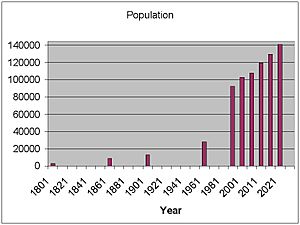
The 2011 census showed that Ashford borough had the biggest population growth in Kent. Its population grew by 14.6% to 118,000 people. Ashford has been a target for population growth since the 1960s. In 1959, 5,000 new homes were built for people moving from London.
According to the 2021 census, most people in Ashford are White (88.1%). Other groups include Asian (5.8%), Black (2.6%), and Mixed (2.2%).
Economy and Business
The soup company Batchelors became a big employer in Ashford. They opened a factory in Willesborough in 1957. This factory is now owned by Premier Foods. Proprietary Perfumes Ltd (PPL), a part of Unilever, opened a factory nearby in 1962. It is now owned by Givaudan.
The frozen food company Brake Brothers started in 1957. They moved to Ashford and grew. Their main European office is now in Eureka Park. In 2017, Curious Brewing built a factory next to Ashford International station. It opened in May 2019.
In 2004, plans were made to invest £2.5 million in Ashford. This included building 31,000 new homes and creating 28,000 new jobs. In 2005, a poll ranked Ashford as the fourth-best place to live in the UK. Ashford continues to grow, with new homes planned for areas like Repton Park and Chilmington.
Ashford has several business parks. These include Waterbrook Park, Eureka Science and Business Park, and Orbital Park.
There are three modern shopping centres in town. Park Mall opened in 1985. The main shopping centre is County Square, which opened in 1973. It was expanded in 2008. Outside the town centre is the Ashford Designer Outlet. It was designed by Richard Rogers and attracts about 3 million customers each year. It has won awards for being a great shopping place. In 2018, the Designer Outlet was expanded with 40 new stores. It also has Europe's largest living wall, with over 120,000 plants. This expansion opened in November 2019.
In 2014, Ashford Borough Council started "AshfordFor." This campaign helps attract businesses to invest in the town. They also launched "loveashford.com" to help new businesses in the town centre.
Culture and Community

Ashford has the oldest St John Ambulance unit still running. John Furley, who started the association, was born in Ashford. He also helped create the British Red Cross Society.
The Grosvenor Sanatorium opened in 1915 to help patients with tuberculosis. The philosopher Simone Weil lived in Ashford after escaping France during World War II. She died at the sanatorium in 1943. A road in Ashford is now named Simone Weil Avenue.
Ashford Hospital opened in 1928. It is now used as a health centre. The main hospital in Ashford is William Harvey Hospital, in Willesborough. It is named after William Harvey, who discovered how blood circulates in the body. The hospital opened in 1979.
Important Landmarks
A free grammar school was started in Ashford in the 17th century. It was built next to the church and is now a museum. The church itself is a Grade I listed building.
A Mk. IV tank from World War I was given to the town in 1919. It is in St Georges Square. This tank was not taken for metal during World War II because it had an electricity substation inside it. A cover was built over the tank in 1988.
H.S. Pledge & Sons Ltd built two flour mills in Ashford. They were important employers. The mills closed in 1972. The East Hill Mill was partly destroyed by fire in 1974. It was used as a nightclub until 2014.
The Corn Exchange opened in 1861. It was used for trade, dinners, and dances. It was taken down in 1963.
The Ashford Green Corridor is a park along the two main rivers. It is protected from building because it is on the flood plain. This area includes Victoria Park. The park has a fancy fountain that was given to it in 1912. The Coningbrook Lakes Country Park opened in 2015.
Ashford's main library opened in 1966. In 2010, it became Ashford Gateway Plus. This building offers local council services as well as the library. Other places to visit include Ashford Borough Museum and Godinton House and Gardens.
The first cinema in Ashford was The Picture Palace. The current main cinema is a 12-screen theatre in Eureka Leisure Park. A new six-screen Picturehouse cinema opened in December 2018.
Getting Around Ashford
Train Travel
Ashford station opened between 1842 and 1845. The South Eastern Railway company built its locomotive works in the town. A line to Canterbury opened in 1846. Other lines to Hastings and Maidstone followed. The railway workers had their own village called Newtown.
Ashford International station opened in 1994 with the Channel Tunnel. It served Eurostar trains to London, Lille, Brussels, and Paris. In 1999, the Channel Tunnel Rail Link was improved. This involved digging a large trench near the station.
From 2007 to 2009, trains to Brussels were stopped but later brought back. Since December 2009, domestic trains run on this route. This reduced travel time to London from 88 minutes to about 38 minutes. However, international services were stopped in 2020 due to the COVID-19 pandemic. Eurostar has said they might not start again until 2025.
Road Travel
In Roman times, Ashford was where two main roads met. One went from London to Lympne, and the other from the Weald to Canterbury. In the 1700s, Ashford became a hub when roads were improved.
Ashford's first bypass road opened in 1957. The main road through Ashford is now the M20. It opened in stages between 1981 and 1991. Junctions 9, 10, and 10A serve the town. Other main roads are the A28 to Canterbury and the A2070 to Romney Marsh.
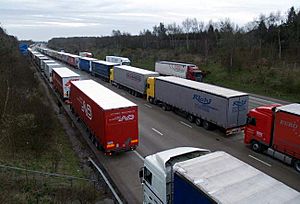
The Ashford Ring Road was finished in 1974 to help with traffic. Part of it involved taking down old buildings. It was changed to a two-way road in 2007. A new junction on the M20, 10A, opened in 2019.
Operation Stack is a system on the M20 near Ashford. It makes large trucks (HGVs) queue for the Channel Tunnel when there are delays. This means the eastbound motorway around Ashford can be closed to other traffic.
Other Ways to Travel
Stagecoach in East Kent provides bus services around Ashford. Buses also go to nearby towns like Canterbury and Folkestone.
The National Cycle Network has two bike routes through Ashford. These are NCR 17 from Rochester to Hythe and NCR 18 from Canterbury to Tunbridge Wells. The Stour Valley Walk also follows the river.
Education in Ashford
Ashford has twelve primary schools, two grammar schools, three secondary schools, and a college. The Norton Knatchbull School was founded around 1630 as a free grammar school. It was known as Ashford Grammar School until 1980. The school has moved several times and is now on Hythe Road.
The grammar school for girls is Highworth Grammar School for Girls. It opened in 1908. There is also a private school, Ashford School, which started in 1898. Boys began to be admitted in 2006.
New primary schools in Ashford include Repton Manor Primary School (opened 2012) and Finberry Primary School (opened 2017). Ashford College moved to a new building in the town centre, which opened in September 2017.
Places of Worship
St Mary's parish church is in the town centre. Parts of it are from the 13th century. John Fogge made big changes to the church in the late 1400s. He added the 120-foot (37 m) tower.
In 2010, the church was changed to be both a place of worship and an arts centre. It can hold up to 350 people for performances. About £1.7 million was spent on improvements.
Sports and Activities
Ashford United Football Club plays at the Homelands, south of the town centre. The club started in 1891. It was reformed in 2011 after money problems.
Ashford has a youth football team called South Ashford Football Club. It started in 2007 for players aged 4 to 21.
The Julie Rose Stadium is an athletics stadium in Willesborough. It opened in 1997 and is named after local runner Julie Rose. It is home to Ashford Athletics Club.
The Stour Centre is a leisure centre near the railway station. It has pools, water slides, gyms, and sports facilities.
Ashford Rugby Football Club started in 1885. They play at Kinneys Field. Ashford also has an archery club and several cricket clubs.
Media in Ashford
Ashford's local radio station was KMFM Ashford. Now, Radio Ashford 107.1 FM is the community radio station. It started broadcasting in May 2011.
Ashford has had several newspapers. The Kent Messenger was published in Ashford until the 1970s. Currently, there are three local newspapers: the Kentish Express, yourashford, and the Ashford Herald.
|
See also
 In Spanish: Ashford (Kent) para niños
In Spanish: Ashford (Kent) para niños


